| |
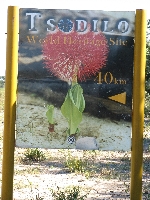 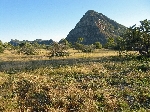 Our
destination for the day was Tsodilo Hills, the highest point in Botswana,
home to thousands of rock art images, a sacred area for the !Kung people
(the "!K" combination is a click sound),
and a World Heritage Site. Our
destination for the day was Tsodilo Hills, the highest point in Botswana,
home to thousands of rock art images, a sacred area for the !Kung people
(the "!K" combination is a click sound),
and a World Heritage Site.
 The
small detail in getting there by bicycle is that it is forty kilometers off the highway,
there are no accommodations, restaurant or store there. And as it
turned out, there is also no water. The road itself was scenic, had
little traffic, was quite passable and at times the surface was
excellent packed clay. The
small detail in getting there by bicycle is that it is forty kilometers off the highway,
there are no accommodations, restaurant or store there. And as it
turned out, there is also no water. The road itself was scenic, had
little traffic, was quite passable and at times the surface was
excellent packed clay.
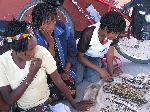  At
the gate to the site were a group of entrepreneurial !Kung girls selling
locally made jewelry. The photo to the right, taken in the site
museum, allows you to compare how the traditional style has evolved into the
styles currently being sold to tourists. At
the gate to the site were a group of entrepreneurial !Kung girls selling
locally made jewelry. The photo to the right, taken in the site
museum, allows you to compare how the traditional style has evolved into the
styles currently being sold to tourists.
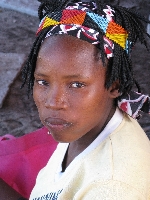 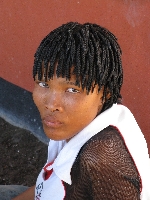 The girls, besides being personable, but firm business
woman, spoke at least their own language, Mbukushu and English. This
should be where I have an introduction to !Kung greeting, but it is a
"click-language" and the greetings include click sounds. Despite some
effort, I failed miserably at learning even a single greeting. I
couldn't tell where in the mouth the click was formed (there are five kinds
of clicks, each is initiated by the tongue in a different part of the
mouth), let alone figure out which Latin consonant to assign to the sound. The girls, besides being personable, but firm business
woman, spoke at least their own language, Mbukushu and English. This
should be where I have an introduction to !Kung greeting, but it is a
"click-language" and the greetings include click sounds. Despite some
effort, I failed miserably at learning even a single greeting. I
couldn't tell where in the mouth the click was formed (there are five kinds
of clicks, each is initiated by the tongue in a different part of the
mouth), let alone figure out which Latin consonant to assign to the sound.
 Here
is a very short course on symbols and sounds for the five
clicks: Here
is a very short course on symbols and sounds for the five
clicks:
¤ Bilabial click (kiss)
/ Dental click (tisk)
≠ Alveolar click (pulling blade from alveolar ridge)
// Lateral click (release along cloak cheek)
! Palatal click (retroflex, popping cork)
Our guide through the hills was Phetolo, which translates into
English as “reply” and is how he introduces himself to English speakers.
 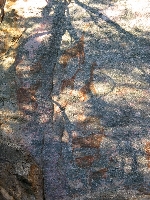 Most
Tsodilo paintings are finger paintings. Red images are older than
white images. The pigments used are made from ground haemitite (red),
charcoal (black) and calcrete (white). The pigments are possibly mixed
with animal fat, blood, marrow, egg-white, honey, sap or urine to help them
adhere and last. The art is scattered around a complex of craggy hills
that require some scrambling to get around. Of the 4,000 individuals
works, wild animals are the most dominate at Tsodilo. Images include, among
others, eland, rhinos, sable, giraffe, elephant, and perhaps most
interesting penguin and whale, which indicates that the artist traveled
quite considerably. Most
Tsodilo paintings are finger paintings. Red images are older than
white images. The pigments used are made from ground haemitite (red),
charcoal (black) and calcrete (white). The pigments are possibly mixed
with animal fat, blood, marrow, egg-white, honey, sap or urine to help them
adhere and last. The art is scattered around a complex of craggy hills
that require some scrambling to get around. Of the 4,000 individuals
works, wild animals are the most dominate at Tsodilo. Images include, among
others, eland, rhinos, sable, giraffe, elephant, and perhaps most
interesting penguin and whale, which indicates that the artist traveled
quite considerably.

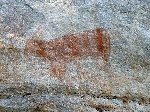

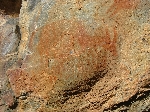

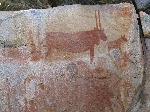

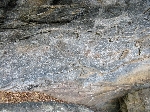 

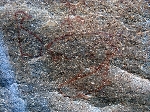

 Oral
tradition states that Tsodilo is where man first came to and walked on earth, and
that it is the
home of the spirit of each animal, bird, insect and plant that has ever been
created. Both the !Kung and the local Mbukushu consider the hills sacred. There are foot-print-like shapes in several rocks that are used as
evidence of man's first steps (right.) Oral
tradition states that Tsodilo is where man first came to and walked on earth, and
that it is the
home of the spirit of each animal, bird, insect and plant that has ever been
created. Both the !Kung and the local Mbukushu consider the hills sacred. There are foot-print-like shapes in several rocks that are used as
evidence of man's first steps (right.)
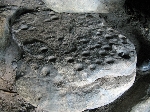 Harder
archeological evidence shows that Tsodilo has been visited and lived at for
thousands of years. There are a couple large caves that would have
been particularly comfortable living spaces. In one of the caves is a
rock with fairly uniform sized hole worn into. We were told that this
is the playing surface for a version of the seed game, of which variations are
found all over sub-Saharan Africa. The game is called "diketlo" in
Setswana and "morabaraba" in Mbukushu. Unlike other examples of the game,
the layout of the holes on the playing surface is quite random. If it is in
fact a game board, it is not clear what the order of play would be or which
"side" would belong to which player. There must be some local ground rules
that have been lost in time. Harder
archeological evidence shows that Tsodilo has been visited and lived at for
thousands of years. There are a couple large caves that would have
been particularly comfortable living spaces. In one of the caves is a
rock with fairly uniform sized hole worn into. We were told that this
is the playing surface for a version of the seed game, of which variations are
found all over sub-Saharan Africa. The game is called "diketlo" in
Setswana and "morabaraba" in Mbukushu. Unlike other examples of the game,
the layout of the holes on the playing surface is quite random. If it is in
fact a game board, it is not clear what the order of play would be or which
"side" would belong to which player. There must be some local ground rules
that have been lost in time.
|
Addendum:
There was in fact no water at the site at
the time of our visit. A wire on their solar voltaic powered pump had
broken several months earlier and a fix didn't seem to be imminent.
There was some water in springs in the hills and villages three miles away
had some traditional wells. In the end we were rescued by a family of
Canadian campers, from Toronto, who had a five liter jug of water they
could spare.For dinner we cooked fish curry and rice on a stove at
the staff housing, and shared it with our benefactor.
The sleeping arrangement was more interesting.
The section of the campground that we choose seemed to be co-located with
where a herd of cows wanted to spend the night. Most of the bovine
were reserved and kept there distance, but there was one white cow that
wouldn't be cowed. And so started the "cow war." In the coarse
of several skirmishes, over a couple of hours, the cow ate a cycling glove
and a pair of socks, and provoked considerable cussing from a couple members
of our group. Eventually the cow stopped returning and most of us got
a good nights sleep.
|























